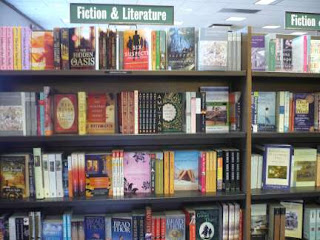The venue for this year's conference was the Mechanics Institute in Manchester, a solid edifice with an imposing stone staircase and walls full of prints and ephemera from the history of the Trades Unions.
Unfortunately I couldn't be in two places at once so I had to make choices about which speakers I would listen to. The first was
Mary Sharratt - seated in amongst us at a round table around which we all squashed ourselves - she was a very popular speaker and rightly so. Her talk on "The Daughters of Witching Hill", her new novel, was exemplary. She gave us plenty of historical detail about the religious and social background to the book - how the Reformation changed attitudes to Catholicism, how the 17th century beliefs in spirits and the power of the cunning woman were repressed during the rise of Puritanism. Her extracts were well-chosen, and we all got to hear her read a little of the voices of the characters, during which you could hear a pin drop. She had photocopied some chapbooks and documents of the time which she referred to, and these added a note of veracity to what was a very well-planned and interesting session. And "The Daughters of Witching Hill" sounds like a great read.
Robert Low was next, talking about Reportage, Re-enactment and Fiction. A very imposing-looking man with a plaited beard, he looks as his readers might hope he would. His lively talk ranged across his experiences as a war reporter and re-enacter. As he pointed out, historical fiction is a genre with no awards, no specific shelf in a bookshop.
And for myself, probably my affinity with Viking, Roman or other so-called Sword and Sandals fiction is about the same as my affinity with Crime or Chick-Lit - i.e they are novels, but that's about as far as it goes. One end of the genre can feel miles away from another, separated by aeons in both time and writing style. So it always feels a little odd for us all to be lumped together in one genre.
But as a novelist Robert had some great things to say about the writer remaining invisible, listed with great good humour. My favourites were "Never open with the weather - the reader is looking for people","Try to leave out the parts readers skip", "If it sounds like writing, re-write it."
He said whatever the accuracy of our research in the end our "only obligation is to be persuasive," and I have to say this seemed a very good argument.
The Panel Discussion, "Where next for Historical Fiction?" chaired by Doug Jackson with
Jim Gill (United Agents)
Marcy Posner (Folio Literary Management) began by looking back to see where the current revival in interest in HF has come from, and traced it back to the rise of interest in historical non-fiction, particularly Simon Schama's History of Britain, and books such as "Longitude" - non-fiction narratives which then paved the way for fiction. Readers like the "added value" of entertainment plus education that some HF provides. However, we need to be wary that we don't become so concerned with being accurate that we forget to write a novel! Story is key.
The conversation ranged over the power of the cover (8 seconds to make your choice in Tesco) to the fact that contrary to most writers' opinions, interest in the Tudors shows no sign of waning. On the contrary, readers like to read books where they already have a smattering of knowledge. Periods the reader has scant knowledge of will fail to sell. The English Civil War, although it has a lot going for it in terms of dramaic action, is apparently a difficult period as readers do not understand the complex causes of the conflict and therefore have no "in" on the subject. (Shame, as that is my period!)
Marcy Posner said there was absolutely no market for WWII novels in the States.
She also said that since the rise of ebooks and self-publishing it was interesting that no less than five new independent bookshops have opened in New York, indicating that the public are wanting a more informed choice and a personal service. Good news for all of us whose books are somewhere in the mid-list.
Both Jim and Marcy agreed that the job of the novelist includes being "out and about", although there is no hard evidence to show (certainly in the States ) that readings and tours work to sell more books. Generally, facebook, tweeting, blogs etc do not necessarily increase your profile as there is so much "information static" drowning out the potential to connect with readers. This was contested by some members who thought that they had successfully used these media to sell their own books.
In the afternoon I listened to a Panel Discussion on A History of Violence" and
Ann Turnbull talking about Love and conflict in the 17th century. This was followed by
Jean Fullerton's presentation "Ground your fiction in Fact." I also had a very entertaining lunch, and a discussion with two other writers about the benefits of the Kindle.More about these in my next post.

























































